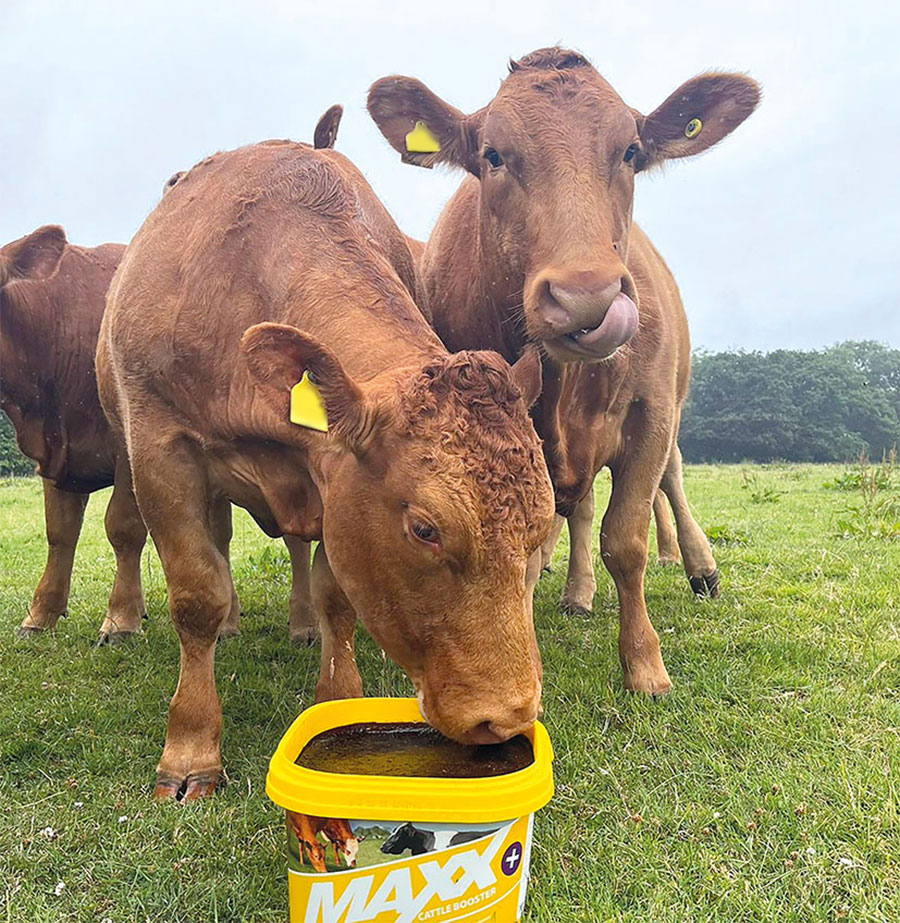Nutrition and breeding management “essential” to hit KPIs
4th April 2024
Replacement heifers and post-calving cows are under a lot of pressure to hit breeding KPIs. Rumenco nutritionist Dr Alison Bond shares how the new formulation of Maxx Cattle Booster Plus will help achieve this.

A new formulation of Maxx Cattle Booster Plus will help support herd fertility when fed to replacement heifers and bulling cows in the run up to, and during, breeding.
According to Dr Alison Bond, nutritionist for Rumenco, Maxx Cattle Booster Plus contains Celmanax, a yeast fermentation culture; Availa performance minerals; high protein levels and easily accessible sugars. This combination of ingredients promotes rumen health, feed digestion, liveweight gain, body condition, milk production and overall performance.
These are all fundamental components to creating a sustainable and economically efficient breeding cattle system by accelerating the age at which a replacement heifer calves down and the speed at which cows gets back into calf post-calving.
Impact on lifetime production
“Age at first calving will have a major effect on the lifetime production of a breeding cow whether in the beef or dairy herd. The current target for age at first calving is around 24 months of age, resulting in one more calf during their time in the herd compared to a heifer not calving down until three years,” explains Dr Bond.
“Not only does this allow producers to accelerate genetic progress by making retainment decisions much more quickly, but it also maximises forage availability. Industry data from Grange Beef Centre shows that calving at three years instead of two results in a 50% lower net margin per hectare for spring calving grass-based systems.”
In the cow herd, the challenge is to have cows back in calf within 80 days of calving to maintain a 365-day calving interval. Ideally, cows will get bred around 60 days post-calving at first oestrus. Data shows that accelerating the rate it takes cows to get back into calf for tighter calving blocks has significant economic benefits. Reducing the calving period from 18 to nine weeks can increase average calf weaning weight by 47kg, with anything extending beyond 12 weeks costing £3.55 per cow per day.
“For both replacement heifers and cows, the sustainability of resource utilisation and economic impact of delayed pregnancy is significant,” says Dr Bond. “However, current figures for the UK indicate the average calving interval to be 440 days with approximately 88 calves being born for every 100 cows or heifers. AHDB’s target is 94 calves born per 100 cows or heifers put to the bull – meaning, there’s room for improvement.”
Nutritional support for improved fertility
To achieve these reproduction KPIs, nutritional support is critical.
In heifers, sexual maturity is influenced by weight rather than age. According to Dr Bond, cattle farmers should aim to maximise liveweight gain, monitoring and weighing regularly to achieve a bulling weight that is 65% of the heifer’s mature weight and approximately 90% of mature weight at calving.
“This means that heifer calves must grow at around 0.7–0.9kg/day. A heifer that doesn’t reach its growth target, but still conceives, will struggle to get in calf as a second calver as the pressure required on the newly calved heifer in terms of growth,” she says.
For post-calving cows, nutritional support is needed to build back and maintain body condition as the lactation period and breeding window crossover each other.
According to Dr Bond, the new formulation of Maxx Cattle Booster Plus makes it ideal for grazing and housed breeding cattle.
“A dehydrated molasses bucket made with patented manufacturing, Maxx Cattle Booster Plus has one of the highest sugar declarations on the market. This will feed rumen microbes so protein available in both the bucket and in other feed will be fully utilised,” she says.
Part of the reformulation is the inclusion of Celmanax, a yeast fermentation culture. “Celmanax is a yeast fermentation culture that has been shown to improve ruminant performance by supporting a stable rumen environment. This has proven to deliver benefits to daily liveweight gain and feed utilisation,” explains Dr Bond.
It also includes performance minerals Availa Zinc and Copper, to optimise performance and feed efficiency. Availa minerals offer superior bioavailability as they bypass the rumen, and have been found to support oocyte production and embryo quality post-calving.
“When used in conjunction with good management practices, Maxx Cattle Booster Plus will help fill essential nutrient demands to meet breeding KPIs in both replacement heifers and post-calving cows,” concludes Dr Bond. “This strategic supplementation will yield a return on investment and improve herd sustainability through more efficient resource utilisation and optimised output.”
Read more livestock news
